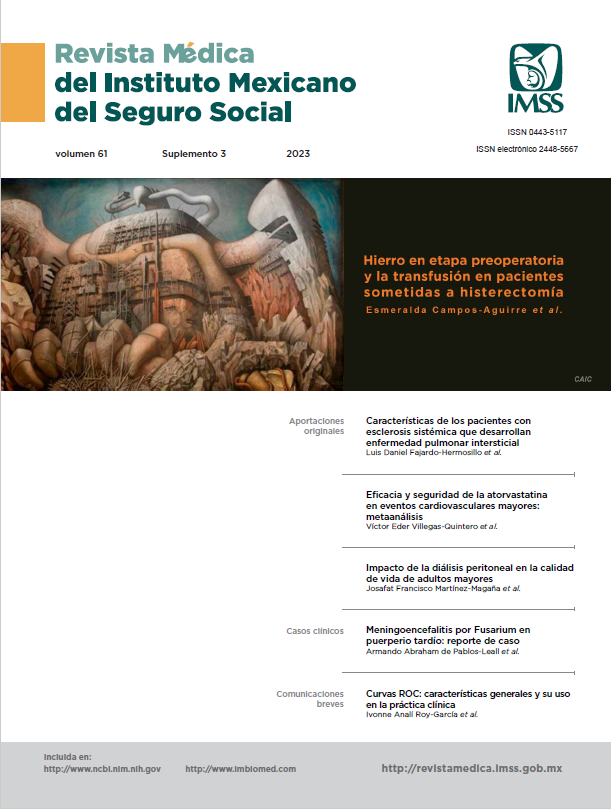ROC curves: general characteristics and their usefulness in clinical practice
Main Article Content
Keywords
Statistics, Area Under Curve, ROC Curve
Abstract
The use of diagnostic tests to determine the presence or absence of a disease is essential in clinical practice. The results of a diagnostic test may correspond to numerical estimates that require quantitative reference parameters to be transferred to a dichotomous interpretation as normal or abnormal and thus implement actions for the care of a condition or disease. For example, in the diagnosis of anemia it is necessary to define a cut-off point for the hemoglobin variable and create two categories that distinguish the presence or absence of anemia. The method used for this process is the preparation of diagnostic performance curves, better known by their acronym in English as ROC (Receiver Operating Characteristic). The ROC curve is also useful as a prognostic marker, since it allows defining the cut-off point of a quantitative variable that is associated with greater mortality or risk of complications. They have been used in different prognostic markers in COVID-19, such as the neutrophil/lymphocyte ratio and D-dimer, in which cut-off points associated with mortality and/or risk of mechanical ventilation were identified. The ROC curve is used to evaluate the diagnostic performance of a test in isolation, but it can also be used to compare the performance of two or more diagnostic tests and define which one is more accurate. This article describes the basic concepts for the use and interpretation of the ROC curve, the interpretation of an area under the curve (AUC) and the comparison of two or more diagnostic tests.
References
Talavera JO, Wacher-Rodarte NH, Rivas-Ruiz R. Clinical research II. Studying the process (the diagnosis test). Rev Med Inst Mex Seguro Soc. 2011;49(2):163-70.
Obuchowski NA. An ROC-type measure of diagnostic accuracy when the gold standard is continuous-scale. Stat Med. 2006;25(3):481-93. doi: 10.1002/sim.2228.
Mandrekar JN. Receiver operating characteristic curve in diagnostic test assessment. J Thorac Oncol. 2010;5(9):1315-6. doi: 10.1097/JTO.0b013e3181ec173d.
Cui Y, Cao W, Li Q, Shen H, Liu C, Deng J, et al. Evaluation of prostate cancer antigen 3 for detecting prostate cancer: a systematic review and meta-analysis. Sci Rep. 2016;10(6): 25776. doi: 10.1038/srep25776.
Bartziokas K, Kostikas K. Lactate dehydrogenase, COVID-19 and mortality. Med Clin (Barc). 2021;156(1):37.
Bennouar S, Bachir Cherif A, Kessira A, Hamel H, Boudahdir A, Bouamra A, Bennouar D, Abdi S. Usefulness of biological markers in the early prediction of corona virus disease-2019 severity. Scand J Clin Lab Invest. 2020;80(8):611-618. doi: 10.1080/00365513.2020.1821396.
Nahm FS. Receiver operating characteristic curve: overview and practical use for clinicians. Korean J Anesthesiol. 2022; 75(1):25-36. doi: 10.4097/kja.21209.
Yao J, Bai T, Yang B, Sun L. The diagnostic value of D-dimer in acute aortic dissection: a meta-analysis. J Cardiothorac Surg. 2021;16(1):343. doi: 10.1186/s13019-021-01726-1.
Wussler D, Kozhuharov N, Tavares-Oliveira M, Bossa A, Sabti Z, Nowak A, et al. Clinical Utility of Procalcitonin in the Diagnosis of Pneumonia. Clin Chem. 2019;65(12):1532-1542. doi: 10.1373/clinchem.2019.306787.
Ye S, Lim JY, Huang W. Statistical considerations for repeatability and reproducibility of quantitative imaging biomarkers. BJR Open. 2022;4(1):20210083. doi: 10.1259/bjro.20210083.
Martínez-Camblor P, Pardo-Fernández JC. The Youden Index in the Generalized Receiver Operating Characteristic Curve Context. Int J Biostat. 2019;15(1):/j/ijb.2019. doi: 10.1515/ ijb-2018-0060.
Aguglia A, Natale A, Fusar-Poli L, Gnecco GB, Lechiara A, Marino M, et al. C-Reactive Protein as a Potential Peripheral Biomarker for High-Lethality Suicide Attempts. Life (Basel). 2022;12(10):1557. doi: 10.3390/life12101557.
Wu S, Du Z, Shen S, Zhang B, Yang H, Li X, et al. Identification and Validation of a Novel Clinical Signature to Predict the Prognosis in Confirmed Coronavirus Disease 2019 Patients. Clin Infect Dis. 2020;71(12):3154-3162. doi: 10.1093/ cid/ciaa793.
Tristán-Martínez PD, Doubova SV, Sauceda-Valenzuela AL. Calidad de atención en pacientes con cáncer de próstata atendidos en México. Rev Med Inst Mex Seguro Soc. 2022; 60(3):275-282. PMID: 35759755.
Zhu X, Xue J, Liu Z, Dai W, Xu H, Zhou Q, et al. The Lactate/ Albumin Ratio Predicts Mortality in Critically Ill Patients with Acute Kidney Injury: An Observational Multicenter Study on the eICU Database. Int J Gen Med. 2021;14:10511-10525. doi: 10.2147/IJGM.S339767.
Yu W, Park E, Chang YC. Comparison of Paired ROC Curves through a Two-Stage Test. J Biopharm Stat. 2015;25(5):881- 902. doi: 10.1080/10543406.2014.920874.
Song J, Li Z, Yao G, Wei S, Li L, Wu H. Framework for feature selection of predicting the diagnosis and prognosis of necrotizing enterocolitis. PLoS One. 2022;17(8):e0273383. doi: 10.1371/journal.pone.0273383.
Chen J, Mu F, Gao K, Yan C, Chen G, Guo C. Value of abdominal ultrasonography in predicting intestinal resection for premature infants with necrotizing enterocolitis. BMC Gastroenterol. 2022;22(1):524. doi: 10.1186/s12876-022-02607-0.
Liu Z, Li D, Liu X, Zhang B, Zang Y, Ma J, et al. Elevated Serum Procalcitonin to Predict Severity and Prognosis of Extensive Burns. J Invest Surg. 2022;35(7):1510-1518. doi: 10.1080/08941939.2022.2073489.
Stocker M, van Herk W, El Helou S, Dutta S, Schuerman FABA, van den Tooren-de Groot RK, et al. C-Reactive Protein, Procalcitonin, and White Blood Count to Rule Out Neonatal Early-onset Sepsis Within 36 Hours: A Secondary Analysis of the Neonatal Procalcitonin Intervention Study. Clin Infect Dis. 2021;73(2):e383-e390. doi: 10.1093/cid/ciaa876.


